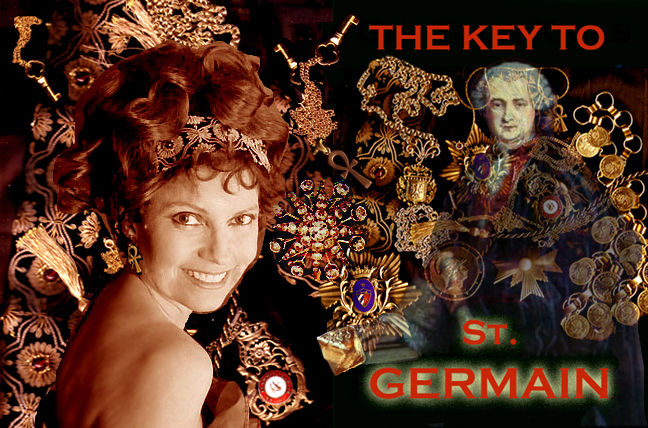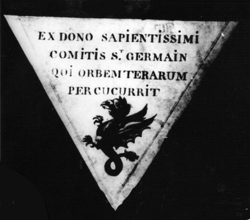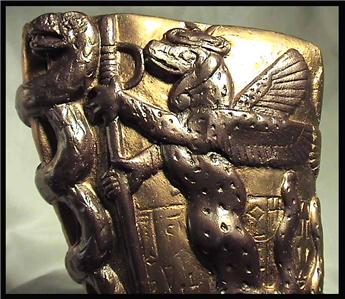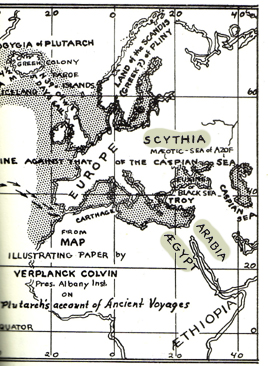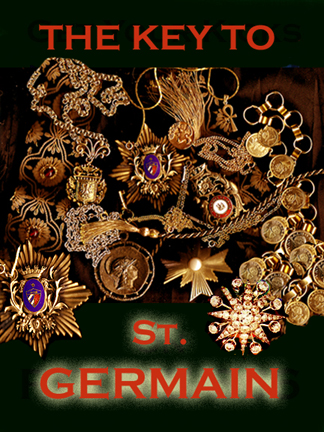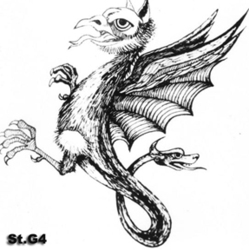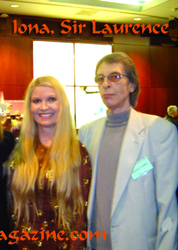Dragon Sign
THE SAINT-GERMAIN CODE: Part III ~ St. Germain & the Dragon
ST. GERMAIN & THE DRAGON
Triangle Book of the Dragon
By Iona Miller, 9/2007
The dragon of alchemy "devours, fertilizes, begets, slays,
and brings itself to life again."
Pymander is the "Thought Divine" personified.
Secrets of the Dragon
The untold tale of St. Germain and the Dragon is hinted at in the first sentence of his Triangle Book: “The Holy Magic revealed to Moses discovered within an Egyptian monument and preciously preserved in Asia under the emblem of a winged dragon.” The current of nature's own primordial power runs through the dragon's body. We need to remember it, to find it again and evoke that essential energy , which is how the body processes light.
This is the secret "hidden since before the Great Flood"…a dual secret of mythic immortality and divine lineage. At first this might seem like a strictly alchemical statement, but then we know there is no such thing for alchemy has many layers of meaning, and ciphers add more. Nothing is simply what it seems.
1. To find things lost in the seas since the flooding of the globe.
Massive Impactor
The answers are hidden in the mists of time. It is plausible that the Great Flood stories originated in a comet strike in the Indian Ocean 4800 years ago. Shortly thereafter Sumerian civilization arose with its myth of Floods and great watery dragons -- The 3mile wide comet slammed into the ocean, radiating a fireball, shockwaves and Mega-Tsunamis that scoured the landscape and scorched the air, and released incredible electrical discharges and torrential rains of ejected ocean water. It was an utter Deluge. The 600 foot high waves carried huge deposits of sediment to land. Half the population died.
The dragon's form arose from his particular power of control over the waters of the earth and gave rise to many of the attributes singled out by different peoples as the whole myth developed. They were believed to live at the bottom of the sea, where they guarded vast treasure hoards, very frequently of pearls. Rain clouds and thunder and lightning were believed to be the dragon's breath, hence the fire-breathing monster. The significance of the dragon was its control over the destiny of mankind.
So, we must ask specifically, what did this winged dragon mean to St. Germain? There are many answers, depending on what level we examine. What does it mean in history, in alchemy and in the context of the Triangle Book? Where did the book come from? Was it an heirloom of his family, a treasure from the Medicis, or St. Germain's own artistic alchemical manifesto -- a virtuoso piece, uniting all his fantasies about his family, his heritage and his alchemical aspirations for life extension and magical illumination.The Medicis who later fostered young St. Germain were the first to print the Corpus Hermeticum (1460). They thought it was ancient Egyptian though the writings are from 100-300 CE. Whatever their origin, the young Count could not have avoided reading them with great interest and embracing their philosophy.
Librarian Casare Cantu in Illustri Italiani, ii, 18 says, “The Marquis of San Germano appears to have been the son of Prince Ragotszy (Ragoczy) of Transylvania; he was also much in Italy…protected by the last Grand Duke of Tuscany, who had educated him,” presumably at the University of Sienna. He was placed in the care of the last Duc de Medici (Gian Gastone) and carried the Hermetic legacy forward zealously.
Prince Karl of Hesse, who knew him well, said, "This House (Medici), as is well known, was in possession of the highest knowledge, and it is not surprising that he should have drawn his earlier knowledge from them; but he claimed to have learned that of Nature by his own application and researches. He thoroughly understood herbs and plants, and had invented the medicines of which he constantly made use, and which prolonged his life and health."
SUMERIAN WINGED DRAGON RELIEF
Relief Casting Of Roll-Out Impression From The Votive Chalice Of King Gudea Of Lagash
A rare workshop casting of a relief impression from the ritual Libation Cup of King Gudea of Lagash from around 2100 BC. The relief portrays a unique depiction of the ancient Sumerian lion-serpent-dragon Tiamat, standing guard over the terrestrial Tree Of Life, which is entwined with a serpent. The image is repeated on both sides of the original cup, forming one of the oldest known images of the snake and the caduceus.
These days on exhibition in the Louvre Museum, the votive chalice was a favourite possession of King Gudea, who ruled the Mesopotamian city of Lagash from 2141 to 2122 BC. However the cup itself has been dated to as early as 4000 BC, which would explain the archaic Sumerian iconography and perhaps, the earliest known depiction of the Dragon in Indo-European history. The cuneiform inscription reads:
"To the god Ningizzida, his god Gudea, patesi of Lagash, for the prolongation of his life, has dedicated this."
It is said that Ningizzida is identified with the star goddess Ishtar, who is also identified with the celestial Dragon Tiamat and often pictured with a caduceus of serpents climbing the tree of life.
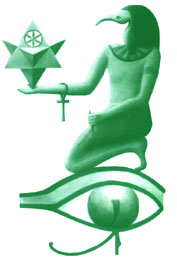
In Egypt, Hermes Trimegistus was thought to be the repository of mankind's knowledge prior to the Flood. In the Book of Hermes, Pymander appears to Hermes in the shape of a Fiery Dragon of "Light, Fire, and Flame." Pymander is the "Thought Divine" personified. In Hermetic lore, Hermes Trimegistus slew the dragon Typhon -- symbolizing ignorance -- using a special staff, the caduceus.
The winged dragon is a symbol that unites heaven with earth, a pictogram of "As Above; So Below." It is the Soverign Intelligence of Light and Life. In yoga the dragon energy is kundalini. Its wisdom is the secret of primal energy hidden in us all, or perhaps more in some than others. The Adept is the reawakened Dragon who is the Universal Medicine, and living Stone.

The Vision of Hermes Trimegestus recounts that "Hermes wandered in a rocky, desolate place to meditate and pray. Following secret instructions of the Temple, he freed his higher consciousness from bondage to his physical senses. Thus released, his divine nature revealed to him The Mysteries. He beheld a terrible, awe-inspiring figure: the Great Dragon, with wings stretching across the sky and light streaming in all directions from its body.
The Great Dragon called Hermes by name, and asked why he meditated on the World Mystery. Terrified, Hermes prostrated himself before the Dragon, beseeching it to reveal its identity. The great creature replied it was Poimandres, the Mind of the Universe, Creative Intelligence, and Absolute Emperor of all.
Hermes besought Poimandres to disclose the nature of the universe and the constitution of the gods. The Dragon acquiesced, bidding Hermes hold its image in his mind. Immediately Poimandres' form changed. Where it had stood was a glorious, pulsating Radiant Light, the spiritual nature of the Great Dragon itself. Hermes was "raised" into the midst of this Divine Effulgence and the material universe faded from his consciousness."
The Key of Alchemy
In Hermetics, the three parts of wisdom are alchemy, astrology and theurgy. Theurgy is reliant on an alliance with divine spirits (i.e. angels, archangels, Gods). There are many of these godnames in the longevity rite in the Triangle Book. Alchemy is the key to theurgy. The disciplines illuminate and potentiate one another. Astrology provides the timing.
Alchemy provides the chemical basis of rejuvination with diet, herbal elixers, even the “white powder” of philosophical gold – monoatomic gold – as a dietary supplement. Sir Laurence Gardner describes this miracle medicine and calls it the true Philosopher’s Stone.
Does Hermes allude to reincarnation when he states: "O son, how many bodies we have to pass through, how many bands of demons, through how many series of repetitions and cycles of the stars, before we hasten to the One alone?"
Hermeticism inspired the Renaissance, Illuminati, Freemasons and Rosicrucians. The Dragon root also may explain why Comte de Saint-Germain was involved in a Jacobite plot to restore the Stuart dynasty to the English Throne (1743). Was his spying in the interests of a shared bloodline?
In fact, this Dragon connection may explain why he was itinerant, not merely a wandering magician, scholar and businessman -- but a man with a mission. Was this dragon emblem the symbol of his natural family? As a Hungarian or Transylvanian prince, was he either part of or in a struggle to restore a bloodline, bred for rulership and magic?
Alchemy always has layer upon layer of meaning, and in this case the emblem and opening sentence conceal a political message of a royal lineage, described since the dawn of history as Dragons. St. Germain was heir to this lineage though the politics of the day necessitated hiding his true identity, much like Sir Francis Bacon had to hide the fact he was the “natural son” of Queen Elizabeth a few decades earlier. In St. Germain's time, the Hapsburgs were allied with the Papacy and overthrew his ancient family.
Alchemical philosophy is often referred to as Hermetic thought. Many books talk about the hermetic school of Tuthmosis III of Egypt, who reigned about 1450 BC. But it is not generally known that the school he originally inherited was the Royal Court of the Dragon. Founded by the priests of Mendes in about 2200 BC it was subsequently ratified by the 12th dynasty Queen Sobeknefru.
Legend says that this sovereign and priestly Order passed from Egypt to the Kings of Jerusalem. Then it passed to the Black Sea Princes of Scythia and into the Balkans - notably to the Royal House of Hungary, whose King Sigismund reconstituted the Court just 600 years ago. Today it exists as the Imperial and Royal Court of the Dragon Sovereignty, and after some 4,000 years it is the oldest sovereign Court in the world.
Here There Be Dragons
An ancient lineage of Hungarian Shamans evolved out of Egypt. The Dragon cult of Egypt emigrated to Hungary and formed the Royal Court of Dragons. It was from this lineage that the Pendragon family came to England.
The Dragon Court can first be identified in Egypt under the patronage of the priest-prince Ankhfn Khonsu at about 2170 BC. It was subsequently established more formally as a pharaonic institution by the twelfth dynasty Queen Sobekh Nefru in 1785 BC.
The Court was re-formed in 1408 by Emperor Sigismund von Luxemburg, King of Hungary, later to become Holy Roman Emperor in 1433. The Dragon kings whom the court has supported have rightfully ruled many nations and empires throughout history. In the case of England, the last legitimate Dragon monarch was Richard III.
Royal Dragon Bloodline; Secret Dragon Wisdom
The Royal Court Of The Dragon was established in Egypt under Ankhfnkhonsu, and more formally by Queen Sobeknefru to provide an institution for the pursuit of the work of the Dragon of Al-Khem otherwise known as Thoth or Hermes.
From Al-Khem we have alchemy, the Great Work of the Dragon. The most famous books attributed to him are The Emerald Tablets and The Pymander. Dragons, the oldest living creature, have been here throughout human history. There have been many legends and manuscripts about these wonderful creatures.
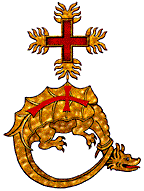
When the Imperial and Royal Dragon Court was reconstituted by King Sigismund in 1408 as the Societas Draconis, it was based upon an ancient bloodline tradition which Sigismund assumed that he had inherited from his presumed Egyptian and Scythian ancestors through the Pictish, Dragon Princess Maelasanu of Northumbria and the Ancient and Original Angevin Royal House of Vere of Anjou, the Imperial Dukes of Angiers.
This line had descended through the Tuatha de Danaan (the Dragon Kings of Anu) on the one hand, and the Egyptian Dragon Dynasty of Sobek on the other. The latter strain included the bloodline of the Davidic House of Judah who married into the descent of the Merovingian Kings of the Franks.
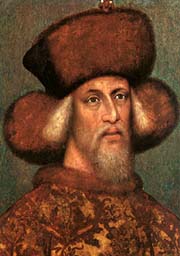
Sigismund assumed a personal entitlement to this legacy in 1397, the date upon which he sought to reconstitute Princess Melusine’s Dragon Court - as Societas Draconis - in a manner that he deemed the most suitable to enhance his power base and establish his royal claims.
Following its subsequent formal inception in 1408, the Court recruited members from a number of prominent royal and noble houses. Historians have noted that these were not particularly known for their religious orthodoxy, including the later House of Vere in England, as one authority on Sigismund’s Dragon Court has asserted.
In 1408 (when Britain was in her Plantagenet era), the Dragon Court was formally reconstituted as a sovereign body at a time of wars and general political turmoil. As we have seen, the Court’s dubious re-emergence was instigated by Sigismund von Luxembourg, King of Hungary.
Having presumptuously and erroneously assumed to have inherited the bloodline legacy in 1397, he drew up a pact with twenty-three royals and nobles who swore to observe ’true and pure fraternity’ within the Societas Draconis, a style subsequently misidentified as the Ordo Draconis (Hungarian: Sarkany Rend). Although the original Court was by no means an Order in the recognized chivalric sense, the misnomer was strategically retained for the purposes of identification.
Along with Sigismund and the twenty-three nobles, Sigismund’s second wife, Barbara Cille (daughter of the Austrian Duke Hermann of Styria), was joint sovereign. Barbara was a Vampire who was taught by Ibrahim Eleazar, the keeper of the Sacred Magic of Abramelin the Mage, and it is she who is the model for the beautiful Countess Carmilla Karnstein in Le Fanus novel of the same name.
Sigismund’s daughter Elizabeth was also a member of the Court, and the inclusion of the entire family thereby achieved the traditional overall standard of twenty six members or two magical circles of thirteen. Others prominent in the Societas Draconis were the Kings of Poland and Aragon, the Duke of Lithuania and the unrepentant heretic, the Duke of Split.
Shortly after this foundation, Sigismund was crowned Holy Roman Emperor and, as a result, the noble fraternity achieved a heightened status as an imperial edifice. Although the Court’s ancient origins were steeped in pre Christian lore, Pope Eugene IV was obliged to approve his Emperor’s non Catholic establishment, for the nature of the Dragon, even if you fake it, is such that its kingly tradition surmounts the mundane constraints of denominational dispute.
Vlad Tepes, a 15th-century Prince in Romania, founded the capital city of Bucharest. His popularised name, Dracula, means "Son of Dracul", and Dracul (or Dragon) was a style by which his father was known within the Grail fraternity of the Ordo Draconis (The Imperial Court of the Dragon) from 1431. As a Transylvanian, there is no way St. Germain would be unaware of this powerful and locally esteemed heritage. His ancestors were Princes of Transylvania -- Dragons in their own right.
Sigismund Rákóczi (Zsigmond)- elected Prince of Transylvania 1607-1608; George I Rákóczi (György) - elected Prince of Transylvania 1630-1648; Rákóczi, Ferenc II (1676–1735). Prince of Transylvania, ruling prince of the allied Hungarian Estates, leader of the anti-Habsburg war of independence. As detailed in Bloodline of the Holy Grail, the brutal Catholic Inquisitions of the Middle Ages were set against all the so-called heretics who in one way or another supported the Messianic Blood Royal (the Sangréal) of the Dragon Kings against the corrupted dogma of the bishops. Many of the victims were classified as occultists and witches, and they were charged with upholding the ancient and heretical cult of Draco, the Prince of Darkness. They were proclaimed by the Church authorities to be vampires! (Gardner, StarFire)
Today, the Imperial and Royal Dragon Court itself exists as a closed fraternity, a collective of individuals, comprising those who, unlike Sigismund, can trace their ancestry and affiliations back to the ancient, pre-Christian Elven, Grail and Dragon families via Anjou.
The Five Holy Obligations of the Order include
1. Protection of the Earth
2. Upholding of Peace
3. Support of the Downtrodden
4. Defence of the Feminine
5. Pursuit of Knowledge
It is in these respects that the Court of the Dragon is most active - supporting at all times the sovereignty of the individual and the responsibilities to protect life and liberty which are inherent within that sovereignty, while pursuing avenues of hitherto suppressed knowledge for the benefit of all. The primary aspects of the Order's constitution are: Nobility, Equity and Justice.
The Court retains the traditional three tier degree system that Sigismund borrowed and to which he appended three separate representations of the alchemical Ouroboros emblem for the distinct ranks of the Court. A fourth emblem, configured in the form of the Egyptian Ankh or Albigensian Cross, was used by the family officers of the Inner Temple.Sir Laurence Gardner on Dragons and St. Germain
St. Germain was clearly motivated by WHO he secretly was, and who he thought he was. We know from the history of Comte St. Germain that he was accused of being a Jacobite, and spying for the Stuarts in England. Historian, Sir Laurence Gardner is a direct link to this hidden agenda today -- virtually a modern day St. Germain, still working for the restoration of his bloodline.
This lineage traces itself to Egypt and is later preserved in Asia, by the Scythians. Coming from Hungary and/or Transylvania, St. Germain, being of noble blood himself, was well aware of this lineage and its symbolic Dragon. Reading between the lines, could this be the hidden cause of his trips to England and his continuous travels throughout Europe and the Orient? Sure, he enjoyed learning new things, but it can be shown that many of his trips were politically motivated. It is significant he worked to restore the Stuarts.
THE SPY IN THE TRIANGLE
Regarding Saint-Germain, Howard writes, "This mysterious occultist claimed Russian, Polish and Italian blood, and was an alchemist, spy, industrialist, diplomat and Rosicrucian. Saint-Germain was active in Europe from 1710 to 1789, during which time he always had the appearance of a man in his early forties. It is said that while studying occultism in the East Comte was introduced to the secret rites of Tantric sex magic which provided him with a technique to prolong his youth. In 1743 he lived for several years in London writing music, and he became a close friend of the Prince of Wales. He was forced to flee from London after becoming entangled in a Jacobite plot to restore the Stuarts, and was exposed as an agent of the French Secret Service. In 1755 he traveled to the Far East to become a pupil of occult adepts in Tibet but he also found time to engage in spying operations against the British India Company."
The word "alchemy", which is the root word of "chemistry", comes from the Arabic al-kimiya - "the science of the black earth land". Kam, or Kem, "Black Earth", was the ancient Egyptian name for their land, referring to the very fertile black earth along the Nile after the seasonal floods. It was the land of the Black Goddess (Nut, Isis, or Hathor), who transmuted into the Black Madonna in Christian times. The name points to the Egyptian origin of alchemy. At its greatest flowering, the ancient Egyptian civilization, which may indeed have been founded by an even earlier Atlantean or even extra-terrestrial civilization, embodied a completely integrated scientific, spiritual and artistic worldview, a sacred science, to use the term of renowned Egyptologist Schwaller de Lubicz.
In the Hellenistic period, the god Hermes, who was Thoth or Djehuti to the Egyptians, and Mercurius to the Romans, emerged as the main deity or spirit guide of the alchemical work of transformation. Thoth was the scientist, scribe and record keeper among the gods. Hermes/Mercury was the divine messenger, carrying knowledge between the divine and human worlds - and thus the practice of divination. Mercury the metal, also called quicksilver, because of its highly mobile, fluid characteristics, became symbolically associated with the mind or awareness. Like quicksilver, the mind can slip and slide to strange elusive places, but it can also shine with sparkling brilliance. In addition to Hermes the god, there was also a legendary, very advanced human spiritual teacher, called Hermes Trismegistos ("Three-fold Great Hermes"). The appellation "Three-fold Great", refers perhaps to the three phases of manifestation of this divine being - as youth, as man and as old man, analogous to the mythic image of the Triple Goddess as maiden, mother and crone.
 This Hermes the Teacher-Adept initiated a whole school of secret knowledge of self-transformation practices, that formed the core of European alchemy, which became known as the Hermetic tradition. Whereas one strand of this knowledge stream concerned itself with the transformation of physical matter, the making of tools, medicines and instruments, the esoteric, mystical core of it were the practices of psychospiritual self-transformation. The most important of the material tools, including plant or fungal or mineral tinctures, as well as metallic instruments, were those that contributed to the practices of consciousness transformation. The secrecy in this tradition was so profound that the term "hermetically sealed" is still a symbolic expression of absolute secrecy. The teachings of the school were not secret arbitrarily or for reasons of power and control, as is sometimes assumed. Rather, they were secret, for the same reason that esoteric yogic and shamanic practices are kept secret, -- because misuse of the knowledge by those motivated by greed or power could have harmful consequences. Later, during the European Middle Ages, because of the persecutory dominance of the Catholic Church, such practices, like the practices of shamanic witchcraft, were shrouded in secrecy because of the very real danger of persecution. Texts were written and illustrated, but in a symbolic code, known only to initiated students, and copied and passed on. The keys to the code were largely lost in the course of time, and the texts became increasingly garbled and incomprehensible.
This Hermes the Teacher-Adept initiated a whole school of secret knowledge of self-transformation practices, that formed the core of European alchemy, which became known as the Hermetic tradition. Whereas one strand of this knowledge stream concerned itself with the transformation of physical matter, the making of tools, medicines and instruments, the esoteric, mystical core of it were the practices of psychospiritual self-transformation. The most important of the material tools, including plant or fungal or mineral tinctures, as well as metallic instruments, were those that contributed to the practices of consciousness transformation. The secrecy in this tradition was so profound that the term "hermetically sealed" is still a symbolic expression of absolute secrecy. The teachings of the school were not secret arbitrarily or for reasons of power and control, as is sometimes assumed. Rather, they were secret, for the same reason that esoteric yogic and shamanic practices are kept secret, -- because misuse of the knowledge by those motivated by greed or power could have harmful consequences. Later, during the European Middle Ages, because of the persecutory dominance of the Catholic Church, such practices, like the practices of shamanic witchcraft, were shrouded in secrecy because of the very real danger of persecution. Texts were written and illustrated, but in a symbolic code, known only to initiated students, and copied and passed on. The keys to the code were largely lost in the course of time, and the texts became increasingly garbled and incomprehensible.
Both are Inside Outsiders, working at the fringes of the System. The "outsider" aesthetic is charged by a desire to break free from the contrivances of tradition. They look boldly outside the system and deep within themselves for inspiration that arises directly from Creative Source.
Both work sub rosa. This phrase comes from the Latin meaning 'under the rose' for confidentiality, black ops. It comes from the Masonic fraternal tradition. The rose is the emblem of Horus, God of Silence and Secrecy.In exerting social engineering and hidden agendas, adepts claim to work toward the greater good of mankind -- philanthropy. But, in the end the Great Work of alchemy is one of individuation. The Magnum Opus, the Great Work of alchemy, is the utter transformation of oneself into a being of light, an energy body.
DRAGON HOUSE
Ferenc of Rákóczi II Prince of Transylvania was Head of the First Hungarian Liberation Battle for the re-establishment of the Hungarian Kingdom Authority in the fight for independence against the Habsburg Conquest. This was a movement of all Hungarian people, a spiritual struggle and sacred affair of the ancient Hungarian society.
At his own expense, he led the nearly successful revolt against the Hapsburg dictatorship in 1703-1711. He was born of an aristocratic Magyar family. Both his father and stepfather led insurrections against the Habsburgs. St. Germain would have grown up in the same atmosphere of fervent Magyar patriotism and the Habsburg's arguably feared he would carry on the tradition.
The first Habsburg King acquired the Hungarian throne in a deal with the Papacy, unacceptable to the people. The Hungarian elites ridiculed the Habsburg Clan in the face of the Hungarian Royal State Formation. Independence of the Habsburg Clan, and the reestablishment of the authority of the Hungarian State Authority in her territory was the crucial cultural movement of the Hungarian nation. The platform was unanimous in all social and ethnic groups of the country.
Comte St.Germain, first son of Ferenc Rákóczi was kidnapped by the Habsburg clan as a punishment of Prince Rákótzi's sentiments and revolt against the Habsburgs. The Habsburgs insisted he be adopted by the French Comte Family of St.Germain. Is it any wonder he travelled incognito the rest of his life?
Joseph Rákóczi was the second son of Prince Ferenc Rákóczi and Amalie princesse of Hessen, born in the French emmigration of her father. The Conceptor and Head of the 2th Hungarian Liberation's Battle against the Habsburg Empire was excommunicated by the Pope for this mission.
In 1784, the Bavarian Illuminati attempted to overthrow the Hapsburgs. ... The Comte de Saint Germain, was also a paid agent of the French Revolution. Times were tough and whole populations pressed for reforms.
Scientists call it the Little Ice Age--but its impact was anything but small. From 1300 to 1850, a period of cataclysmic cold caused havoc. It froze Viking colonists in Greenland, accelerated the Black Death in Europe, decimated the Spanish Armada, and helped trigger the French Revolution. The Little Ice Age reshaped the world in ways that now seem the stuff of fantasy--New York Harbor froze and people walked from Manhattan to Staten Island, Eskimos sailed kayaks as far south as Scotland, and 'the year without a summer' saw two feet of snow fell on New England one June and July."
Sir Laurence Gardner has quite a CV: Chancellor of the Royal Court of the Dragon Sovereignty, which first emerged in Egypt in around 2,200BC and is now based in Britain; Prior of the Celtic Church's Sacred Kindred of St Columba, and an "internationally known sovereign and chivalric genealogist" Chevalier Labhran de Saint Germain."
Gardner is Presidential Attache to the European Council of Princes - a constitutional advisory body established in 1946" formally attached to the Noble Household Guard of the Royal House of Stewart, founded at St German-enLaye in 1692, and is the Jacobite Historiographer Royal.
Sir Laurence himself calls the Merovingian "Holy Grail" bloodlines the "dragon" bloodlines, but claims that this term derives from the use of crocodile fat in the royal anointing ceremonies of ancient Egypt.
"In 1408... the Dragon Court was formally reconstituted as a sovereign body at a time of wars and general political turmoil. The Court's reemergence was instigated by Sigismund von Luxembourg, king of Hungary, a descendant of the Lusignan Dragon Kings of Jerusalem.
*
Having inherited the legacy in 1397 he drew up a pact with twenty-three nobles who swore to observe 'true and pure fraternity' within the Societas Draconis (later called Ordo Draconis) — Hungarian: Sarkany Rend. The founding document... stated that members of the Court might wear the insignia of a dragon incurved into a circle, with a red cross — the very emblem of the original Rosicrucis which had identified the Grail succession from before 3000 B.C."
*
"The House of Stuart, deposed in 1688, having taken over the presidency of the Council from the House of Habsburg-Austria, related it to its one-time Royal Academy, which was a very scientific establishment. In fact, in the 1700s in particular, it was highly Rosicrucian - very scientific and alchemical.
*
From the time of Robert the Bruce, the Chancellor of that organisation was given the title Prince Saint Germain. This title had little to do with the 5th-century saint himself (except indirectly), but it had to do ultimately with the Stuart Royal Court in France, at the Palace of Saint Germain.*
*
The Chancellor title was changed in the 1700s to Count Saint Germain, and in the 1890s it was changed again to become Chevalier Saint Germain. Sir Laurence Garnder’s present title is that of Chevalier Saint Germain - which is where the knighthood comes from. As distinct from an English knighthood, his is a Franco-Scot distinction attached to the Stuart Royal Court of France [as ratified by King Louis XIV in 1692], in the key Noble Order of the Royal Palace of Saint Germain-en-Laye, near Paris."
Why was the kingly line which descended to Jesus and beyond so unique from the outset in old Mesopotamian times? The Messianic succession of Grail dynasts (or Dragon Kings) was alchemically conceived and purpose-bred for the role of earthly leadership.
The records of ancient Sumer talk of the Anunnaki gods and their "creation chamber". The great vulcans of the era produced the enigmatic Highward Fire-stone (the white powder of monatomic gold) that was used to feed the Light-bodies of the Babylonian Kings and Egyptian Pharaohs. This substance, when ingested, had stunning effects on the body's endocrinal system. The senior line of royal descent (a line that was genetically determined by the mitochondrial DNA of the Dragon Queens) can be followed down to the time of Moses.
As explained in Genesis of the Grail Kings, the monarchs of the Grail succession were called Messiahs (Anointed Ones) because, in the early days in Mesopotamia and Egypt, they were anointed with the fat of the sacred Messeh (the holy dragon or crocodile). By virtue of this, they were also called Dragons.
The Dragon, emblematic of wisdom, was the epitome of the Holy Spirit which, according to the Book of Genesis, moved upon the waters of time, while the Grail was the perpetual Blood Royal - the Sangréal. Originally, in old Mesopotamia, it was called the Gra-al - the Sacred Blood of the Dragon Queens - and it was said to be the "nectar of supreme excellence". The ancient Greeks called it ambrosia."
In Britain, the Tuatha Dé Danann (or Dragon Lords of Anu) were masters of the transcendent Sidhé, and were duly classified as "fates" or "fairies". Before settling in Ireland (from about 800 BC), they were the world's most noble race, alongside the early Kings of Egypt, being the Black Sea Princes of Scythia (now Ukraine).
Like the original dynastic Pharaohs, they traced their descent from the great Pendragons of Mesopotamia; and from them sprang the kingly lines of the Irish Bruithnigh and the Picts of Scotland's Caledonia. In Wales they founded the Royal House of Gwynedd, while in Cornwall in the southwest of England, they were the sacred gentry known as the Pict-sidhé - from which derives the term "pixie".
So, from a single caste of the original Blood Royal - whether known as the Sangréal, the Albi-gens or the Ring Lords - we discover many of the descriptive terms which sit at the very heart of popular folklore. For here, in this one noble race, we have the "elves", "fairies" and "pixies" - not beguiling little folk, but distinguished Kings and Queens of the Dragon succession.
Genesis of the Grail Kings
The Royal and Imperial Dragon Court and Order, in conjunction with the The Dragon Court, led by HRH Prince Nicholas de Vere von Drakenberg, is an ancient order charged with preserving the royal Dragon bloodline, the secret Dragon wisdom, and the sacred Dragon tradition. The Dragon bloodline has been elsewhere described as the “Grail bloodline”, and the Dragon kings are the same as the popularly-known “Grail kings,” including the Merovingians.
The Dragon Court can first be identified in Egypt under the patronage of the priest-prince Ankhfn Khonsu at about 2170 BC. It was subsequently established more formally as a pharaonic institution by the twelfth dynasty Queen Sobekh Nefru in 1785 BC.
The Court was re-formed in 1408 by Emperor Sigismund von Luxemburg, King of Hungary, later to become Holy Roman Emperor in 1433. The Dragon kings whom the court has supported have rightfully ruled many nations and empires throughout history. In the case of England, the last legitimate Dragon monarch was Richard III.
In Sumer, the storm god who eventually became known as Jehovah was called 'Enlil' or 'Ilu-kur-gal' (meaning 'Ruler of the Mountain'), and his brother, who became Adon, the Lord, was called 'Enki'. This name is really important to our story because 'Enki' means 'Archetype'.
The texts inform us that it was Enlil who brought the Flood; it was Enlil who destroyed Ur and Babylon, and it was Enlil who constantly opposed the education and enlightenment of humankind. Indeed, the early Syrian texts tell us that it was Enlil who obliterated the cities of Sodom and Gomorrah on the Dead Sea - not because they were dens of wickedness, as we are taught, but because they were great centres of wisdom and learning.
It was Enki, on the other hand, who, despite the wrath of his brother, granted the Sumerians access to the Tree of Knowledge and the Tree of Life. It was Enki who set up the escape strategy during the Flood, and it was Enki who passed over the time-honoured Tables of Destiny - the tables of scientific law which became the bedrock of the early mystery schools in Egypt.
Many books talk about the Hermetic school of Tuthmosis III of Egypt, who reigned about 1450 BC. But it is not generally known that the school he originally inherited was the Royal Court of the Dragon. This had been founded by the priests of Mendes in about 2200 BC and was subsequently ratified by the 12th dynasty Queen Sobeknefru.
This sovereign and priestly Order passed from Egypt to the Kings of Jerusalem; to the Black Sea Princes of Scythia and into the Balkans - notably to the Royal House of Hungary, whose King Sigismund reconstituted the Court just 600 years ago. Today it exists as the Imperial and Royal Court of the Dragon Sovereignty, and after some 4,000 years it is the oldest sovereign Court in the world.
Draco was a divine emblem of the Egyptian Pharaohs, a symbol of the Egyptian Therapeutate, of the Essenes at Qumran, and was the Bistea Neptunis (the sea serpent) of the descendant Merovingian Fisher-Kings in Europe.

Nicholas de Vere describes his Dragon legacy: In brief, the recorded Dragon lineage starts with the Annunaki and descends through the proto-Scythians, the Sumerians in one branch and the early Egyptians in another; the Phoenicians, the Mittani, back to the Scythians again through marital alliance, along to the "Tuatha de Danaan" and the Fir Bolg; down through their Arch-Druidic, Priest-Princely families, to the Royal Picts of Scotland and the high kings of the Horse Lords of Dal Riada; through to the Elven dynasty of Pendragon and Avallon del Acqs, and down to a few pure bred families today.
From the Ogdoad, who were the first Dragon god-kings of ancient proto-Scythia, we obtain the gods of the Anunnaki, and those later pantheons that derived from them. It is not to be doubted that after the Flood the children of the Anunnaki had established incredible civilisations in their time, so I suppose you could say that the cultures of the Sumerians (whose language, termed "proto-Sumerian", originated in Transylvania), the Egyptians and even the early settlers in northern Europe stemmed from and reflect an antediluvian prototype, a much older pre-Flood "Golden Age" presided over by the ancient Dragon god-kings and goddess-queens. The mistake would be to put the Atlantean period too far back in time and to locate Atlantis where Plato did. Scientists have proved the Biblical Flood to be in the Black Sea and this region is where most of the Titanic and Olympian sagas, associated with the Dawn of the Gods, unfold.
"The Dragon" is a term I use generally to mean the dragon archetype resting within the Dragon blood and passed on through the genes. It is the conduit through which flow the memories of the wisdom and experience of the Dragons who have gone before. The word "dragon" is derived from the Greek "edrakon", which is an aorist of the word "derkesthai", which means "to see clearly". "The Dragon" therefore is the inherited Dragon archetype and that archetype is the conduit of clear sight through which racial knowledge flows. Clear sight also and principally refers to transcendent consciousness. http://www.paranoiamagazine.com/mykingdom.html
Libertarian Agenda
Madame Blavatsky's (Yelena Blavatskaya) Great-Grandfather Pavel, and his Brother Alexander and their two close friends, colleagues and Cousins, were colleagues of Eduard Rokoczy's and fellow members of the Association of Adepts. .."The Six Princes". They were equals but Rokoczy was the "Chairman" of the Association of Adepts. The Association of Adepts is not based upon hierarchical principles, in fact, it is unalterably opposed to such principles.
It does take power to fight power. Several Dolgorukii Princes and relatives were executed as a result of their participation in the Revolution of 1905, and their predecessors had suffered the same fate under Catherine the Great. Yelena Petrovna von Hahn (Madam Blavatsky) came by her role of "Freedom Fighter" and Iconoclast very naturally indeed. It's a real shame that the Bolsheviks, in their rush to power, saw fit to murder every member of the Dolgorukii family they could get their hands on. For the Dolgorukii, more than any other Russians, had set the stage for the successful revolution.
The life and works of Prince Eduard Rokoczy show he was the Father of the Age of Revolution that followed the "Age of Enlightenment". There is not one of the many revolutions in the period from 1776 to 1917 that was not entirely inspired by the work of the so-called "Comte de St. Germain" and/or his immediate associates and successors.
From the Renaissance to the present time, the Association of Adepts, sometimes called the Illuminatii, in the pursuit and service of illimitable liberty, have been responsible for all major social changes leading to the increase of human freedom and happiness. They are cultural engineers. http://www.parascience.org/suborn.htm
The Dragon in Alchemy
The winged dragon is a symbol of the spiritualizing of earthly substance.
The Head of the Crow
Oil of Philosophers.

Here is our new black Son born, and the name of him shall be called Elixir. The black earth and feculent is turned into Argent vive as it was afore and dissolved in the colour of oil, and then it shall be called oil of Philosophers.
The Eighth Chapter.
How the Dragon is Born in Blackness and is Fed with his Mercury and Killeth Himself and is Drowned in the Same and the Water is somewhat made White.
Gold is dissolved that he may be reduced unto his first matter, that is that it may be made truly sulphur and Argent vive. For then we may make most best silver and Gold when it is converted into the matter of them. Therefore it must be so well washed until it be true Sulphur, and Argent Vive, for according to the Philosopher they be the very true matters of metals. Therefore he that can wed a wife, and get her with child and mortify and quicken again the kinds of generations, and can cleanse and bring in light, and to separate the shine thereof from blackness and darkness, shall be of most great dignity. Therefore we conjoining our king crowned to our red children and in an easy fire knitting them together, there shall be conceived and between them engendered a son, For his clouds which were upon him turneth again into his body as they came out. Therefore continue a temperate Balneo or bathe until such time all be dissolved into water impalpable, and that all the tincture come out in the colour of Blackness, which is the sign and token of Dissolution.
The dark house is Sulphur of Philosophers.

Here beginneth the Dragon to wax white and to eat his own wings.
The Ninth Chapter.
Here is the Water Cleansed wholly from Blackness and Remaineth in the Colour of Milk, and many Colours doth Appear in the Blackness.
The dragon here eateth his own wings and showeth forth divers colours by many manner of ways and many times shall be moved from colour unto colour until such time it come unto whiteness, A fierce or a most cruel beast ought not to be fed but when it hath thirst and hunger, and know ye that after three days it hath not, then is the Dragon born, the house of him is darkness and blackness dwelling in all these; Truly death, and Darkness, flyeth this Sea, and the dragon flyeth from the bright beams of the Son which stops the holes, and our dead form shall leave, and the king shall come from the fire, and shall rejoice of his marriage. And hidden things shall appear, and the milk of the virgin shall be made white, and our child now quickened is made a tamer or overcomer of ye fire, and overcoming tincture. (Adam McLean commentary www.rexresearch.com/donumdei/donumdei.htm)
